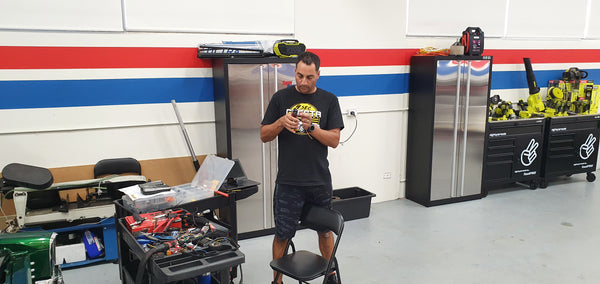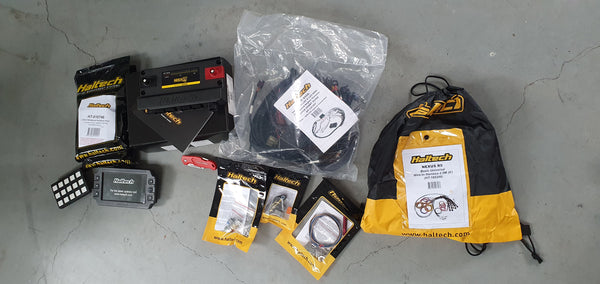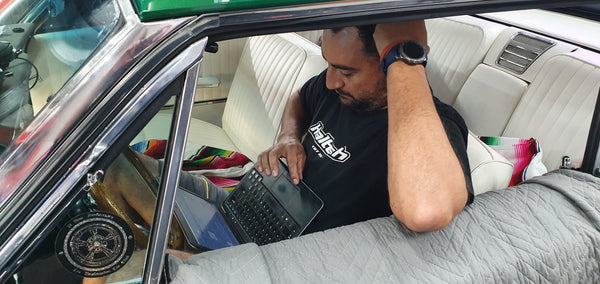
Davo's top tips for avoiding a Wiring Nightmare
If you've watched much Mighty Car Mods over the years you'll have seen Davo come in and be an absolute guru when it comes to wiring up cars (like with Marty's Levorg HERE ). So many car enthusiasts are scared of electrical systems, probably because it is easy to make an absolute mess of it if you're not careful and methodical, like Davo.
So, while he was wiring up my 1964 Pontiac (check out the video on it, HERE) I asked him for his top tips on rewiring cars, and how to avoid ending up with the Forbidden Spicy Spaghetti.

Davo, is wiring up a car scary?
D: No, and yes. *chews nugget* It all depends on how much experience you have with electrical systems. The more you work with them, the more you get to know how they work and how they should be put together. *grabs another nugget* So when you're starting out it is probably a good idea to find a friend who is good with electrical work, watch what they do and ask lots of questions.
Start with small jobs you can find a lot of information about, like installing a headunit or speakers. *sacrifices another nugget* You can gradually build up the difficulty of the jobs as you go so you're not diving straight into something complex like redoing an entire wiring loom.

When it comes to rewiring a car, what is the biggest mistake you see people making?
D: Apart from building Pontiacs? Failing to plan. *sips milkshake* It was really important we sat down and talked about all the electrical parts going into your car before we started work on it, because this made sure I wasn't going to run out of electrical power for functions and I knew what I had to do before we started pulling the car apart.
Writing down the electrical load of all the components in your car, studying wiring diagrams for your make and model, researching what alternator and battery you might need are all among the first steps you should do before you go out and buy an ECU or wiring loom.

So you'd call this job complex? I thought old cars would be easy to wire given how simple they are...
D: The more electrical "stuff" you have in your car, the more complex it is. And with your new drivetrain, you've got a tonne of electrical parts to run in your car, including air suspension, the auto transmission, electric air conditioning (see more HERE), three fuel pumps, an electric pump for your intercooler, two huge thermo fans, a stereo, plus all the normal car features like lights, blinkers, taillights, interior fans and more. And why is there an axolotl under your dash?
We're making this simpler by starting fresh and using the most modern technology available to us with the Haltech Nexus R5 VCU and PD16 power distribution module. We can connect them with simple Deutsch connectors and flying lead looms, saving having to do more crazy wiring.

Is it easier to work on fresh modern cars that are more complex in their wiring and tech, or on simpler older cars?
D: Old cars aren't always easy because the wiring is often so old its actually broken. *nibbles on pate* People don't realise that wires will eventually stop working after five or six decades. Also, it can be hard to find accurate wiring diagrams for old cars and sometimes the switching on old cars can be really fiddly and intricate, like the crazy manual indicator switch on your car. A modern car has a simple electrical switch but yours uses literal levers and rods to activate the indicators and we had to tie into that!

Wiring cars involves a lot of cramming yourself into uncomfortable positions for hours at a time, doesn't it?
D: Yes. *sips pina colada*

After you got the wiring loom planned out what was the next big challenge?
D: Working out where to mount all the hardware in the car, so I could work out how to run all the wires, and how to fit them through a car never designed to have this many wires in its loom! *munches on bruschetta* There really was no space under the dash so the Nexus had to be mounted behind where the original speedo would have gone, meaning that couldn't be refitted. This wasn't too big an issue as you're using a Haltech IC-7 colour dash but it did mean having to make a blanking plate for the hole.

When it comes to wiring a whole car do you think it is easier to try to fix what is there, or start fresh?
D: I think it depends on the car. You could spend weeks and weeks fault-finding an old or unknown wiring loom, looking for broken wires or faulty switches, and this is why it can cost so much to drop your car with an auto electrician and have them go through that job for you; the labour is huge.
In the case of your car the old wiring was completely stuffed so we were always going to start fresh, but even then I'd have done it this way because of all the functions to wire into the car, which weren't originally fitted to it. Also, Iain, why is there chocolate mousse under the ashtray?

Did the Haltech gear make wiring my car easier?
D: Yes because, for instance, the CAN keypad makes switching all the car functions, like indicators, headlights, ignition, and more, much simpler as we don't have to wire up all those independent switches; it's plug-and-play between the R5 VCU and the keypad, then you just assign functions in the NSP software.
On a traditional wiring loom you'd have to individually wire all those functions in through relays, but that isn't an issue with the Nexus.

What was the hardest part?
D: Listening to you prattle on about nonsense for 8-hours a day over 2 months? It would have to be taking the time to sit down and assign all the functions for the car in the NSP software. *takes a bite of his Sundae*
The Nexus R5 can control almost any electronic function you want, but you have to assign each function to a wire and when you're wiring a whole car there are a lot of wires and funcitons to assign long before you ever load a base map in and try hitting the key. This probably took me a couple of weeks to sort out, but it was worth it in the end as the car runs like a modern car!
The biggest thing with wiring is the hard work you put into the planning stage pays off when it comes time to hit the key and power the car up for the first time. Remember to throw your battery on a charger the day before you want to do that so you know you have plenty of power there, too!


![Limited Edition Car Poster [AUTOGRAPHED]](http://mightycarmods.com/cdn/shop/files/ONLY_45AUD_480x480.png?v=1765858723)


